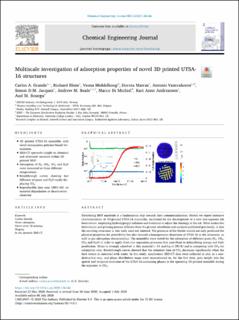| dc.contributor.author | Grande, Carlos Adolfo | |
| dc.contributor.author | Blom, Richard | |
| dc.contributor.author | Middelkoop, Vesna | |
| dc.contributor.author | Matras, Dorota | |
| dc.contributor.author | Vamvakeros, Antonis | |
| dc.contributor.author | Jacques, Simon D.M. | |
| dc.contributor.author | Beale, Andrew M. | |
| dc.contributor.author | Michiel, Marco Di | |
| dc.contributor.author | Andreassen, Kari Anne | |
| dc.contributor.author | Bouzga, Aud Mjærum | |
| dc.date.accessioned | 2022-09-20T06:51:40Z | |
| dc.date.available | 2022-09-20T06:51:40Z | |
| dc.date.created | 2020-12-03T15:29:26Z | |
| dc.date.issued | 2020 | |
| dc.identifier.citation | Chemical Engineering Journal. 2020, 402, 1-9. | en_US |
| dc.identifier.issn | 1385-8947 | |
| dc.identifier.uri | https://hdl.handle.net/11250/3019009 | |
| dc.description.abstract | Structuring MOF materials is a fundamental step towards their commercialization. Herein we report intensive characterization of 3D-printed UTSA-16 monoliths, facilitated by the development of a new non-aqueous ink formulation, employing hydroxypropyl cellulose and boehmite to adjust the rheology of the ink. What makes this formulation and printing process different from the printed adsorbents and catalysts published previously, is that the resulting structures in this work were not sintered. The presence of the binder matrix not only produced the physical properties for printability but also ensured a homogeneous dispersion of UTSA-16 in the structures, as well as gas adsorption characteristics. The monoliths were tested for the adsorption of different gases (N2, CH4, CO2 and H2O) in order to apply them into separation processes that contribute to defossilizing energy and fuels production. Water is strongly adsorbed in this material (~14 mol/kg at 293 K) and is competing with CO2 for adsorption sites. Breakthrough curves showed that the retention time of CO2 decreases significantly when the feed stream is saturated with water. In this study, synchrotron XRD-CT data were collected in situ, in a non-destructive way, and phase distribution maps were reconstructed to, for the first time, gain insight into the spatial and temporal evolution of the UTSA-16 containing phases in the operating 3D printed monolith during the exposure to CO2. | en_US |
| dc.language.iso | eng | en_US |
| dc.publisher | Elsevier | en_US |
| dc.rights | Navngivelse 4.0 Internasjonal | * |
| dc.rights.uri | http://creativecommons.org/licenses/by/4.0/deed.no | * |
| dc.subject | In situ operando XRD-CT | en_US |
| dc.subject | Shaping | en_US |
| dc.subject | Direct write 3D printing | en_US |
| dc.subject | Water adsorption | en_US |
| dc.subject | Carbon dioxide | en_US |
| dc.title | Multiscale investigation of adsorption properties of novel 3D printed UTSA-16 structures | en_US |
| dc.type | Peer reviewed | en_US |
| dc.type | Journal article | en_US |
| dc.description.version | publishedVersion | en_US |
| dc.rights.holder | © 2020 The Authors. Published by Elsevier B.V. | en_US |
| dc.source.pagenumber | 9 | en_US |
| dc.source.volume | 402 | en_US |
| dc.source.journal | Chemical Engineering Journal | en_US |
| dc.identifier.doi | 10.1016/j.cej.2020.126166 | |
| dc.identifier.cristin | 1855914 | |
| dc.relation.project | Norges forskningsråd: 233818 | en_US |
| dc.relation.project | Norges forskningsråd: 193816 | en_US |
| dc.source.articlenumber | 126166 | en_US |
| cristin.ispublished | true | |
| cristin.fulltext | original | |
| cristin.qualitycode | 2 | |

